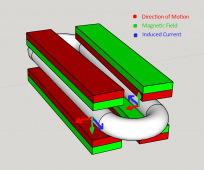brandnewb
Going for serious. starting as newb
wow, I am sooo stupid!!
I just can't solve this theoretically.
right hand rule:
thumb in direction of coil motion.
index pointing from north to south
middle is direction of electron flow.
I am running into limits of brain capacity here in the context of attracting fields like the image above
I just can't solve this theoretically.
right hand rule:
thumb in direction of coil motion.
index pointing from north to south
middle is direction of electron flow.
I am running into limits of brain capacity here in the context of attracting fields like the image above






